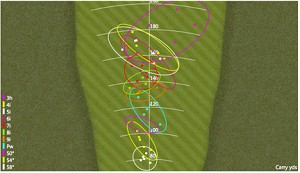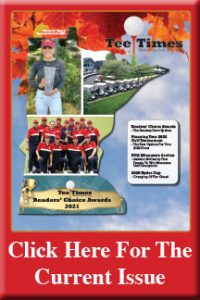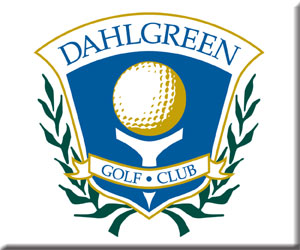The Geometry of Golf – Optimizing Your Golf Bag
By Chris Foley
The geometry of golf is a series of articles that appears in each issue of this summer’s Tee Times magazine. The articles deal with the science of the game of golf. In this series we address some of the myths and misconceptions regarding the golf swing and why the golf ball does what it does. We hope through this series of articles people gain a better understanding of the golf swing and have more success when they play, practice or take a lesson. By applying science to the swing, we can eliminate guesswork. This minimizes confusion and speeds improvement.
Optimizing Your Golf Bag
In our last article we learned about optimizing the driver. In this sixth article in the series, we will learn how to optimize the clubs through out our set.
The optimization of the clubs other than our driver is really a two step process. The first step of the process is ensuring the fairway woods, hybrids, irons and wedges fit the player. The second part is determining if there is the proper gap between clubs and the set of clubs has the right clubs for a players game and level of play.
The fitting process includes determining the correct length of clubs, the shaft flex and material, the lie angle of the club, the size of the grip and with wedges the bounce angle.
In our article on the importance of centered contact we learned that where the ball hit on the club face has a huge influence on the starting direction of the golf ball. When the club is the correct length it gives the player a much better opportunity to consistantly hit the center of the face. The length is determined by a combination of the distance from the ground to the players wrist and where the player is hitting the ball in relation to the center of the club face. When a player is consistantly hitting the ball toward the toe, it is an indication that the club may be too short. Heal hits are an indication that the club may be too long.
If the flex of a shaft is correct a player’s shot disbursion will be tighter. The primary determining factor in determining shaft flex is a player’s club head speed. The faster a players club head speed generally the stiffer shaft they will need.
There are primarly two types of shaft material; steel and graphite. Both offer the same range of flexes. There are a couple of differences between the two. Graphite is generally lighter than steel. In theory, a lighter shaft will allow a player to swing faster and thus hit the ball further. Also, graphite tends to hit the ball higher and has some shock absorbing properties.
The lie angle of the club is the angle between the shaft and the ground when the club is soled flat. If the lie angle is correct the sole of the club will tend to come into impact flat in relationship to the ground. If the lie angle is too flat the club will come into impact with the toe down. This tilts the spin axis of the ball to the right (for a right handed player). A club that is too upright will tilt the spin axis to the left.
Grip size is the diameter of the handle of the club. Grip size affects how a player places the club in his hands. This will influence how he hinges and unhinges his wrist and can affect face rotation.
Another element with wedges, is the bounce angle of the club. The bounce angle is the difference between the leading edge and the trailing edge of the club head. Wedges utilize more bounce than the rest of our irons to allow the club to glide through the turf or sand. Bounce provides forgiveness on shots for the fairway, rough, and sand. A players swing type is the primary determinant of the amount of bounce a player needs. Players with a steeper angle of approach will generally need more bounce that players that have a shallow angle of attach.
The second step to set optimization is looking at the bag as a whole to see if there are the proper gaps between clubs and the right combination of fairway woods, hybrids, irons, and wedges. Ideally, a player should have a gap of 10-15 yards between each club.
For the long game the first thing we need to do is to determine the distance that our longest fairway wood goes and if that club is a 3, 4, or 5 wood. Once that is determinded, we need to learn what is our longest playable iron. Most players reach a point in their long irons where the gap between clubs gets very small or they hit clubs the same distance. For instance the player may hit their five iron 185, their four iron 190, and three iron 192. These clubs don’t have enough gap between them. In this case the five iron would be the longest iron the player should carry. If it is determined that their three wood travels 225 yards there is a 30 yard gap between it and the five iron. In this 30 yard gap we would fill in with two high lofted fairway woods or hybrids.
At the other end of the bag with the wedges, the process is to determine the highest lofted wedge the player can effectively use and the distance that it goes for a full swing. That club could be a 56, 58, or 60+ degree wedge. We then need to determine the distance the player hits their pitching wedge. So for instance, if the player hit PW 125 yards and the highest lofted wedge they effectively hit is 58 degrees. If the 58 degree travels 95 yards, there is a 30 yard gap. The 30 yard gap would be filled with two wedges. If the PW is 46 degrees we would put 50 and 54 degree wedges in the bag and that would give the player gaps and distances for each club.
By optimizing a player’s complete bag it gives them the best opportunity to play their best golf without any holes or overlaps. They are also able to use every club.







